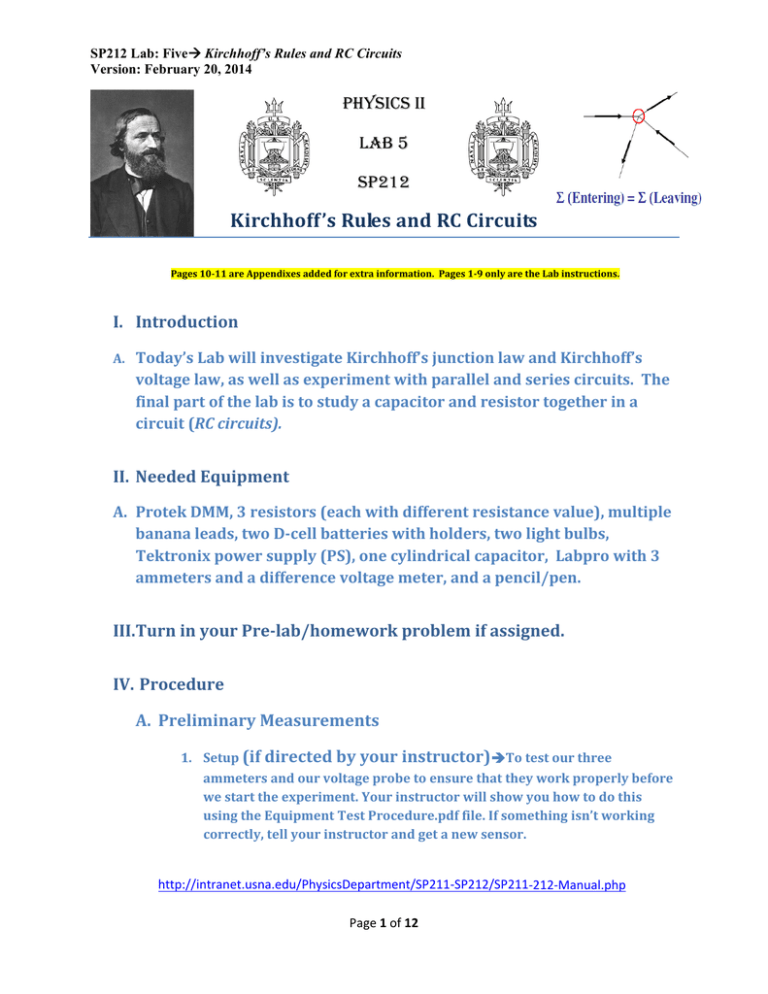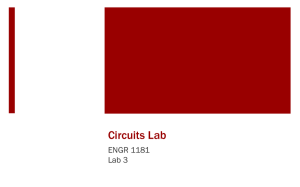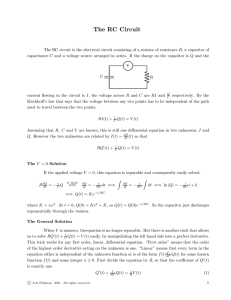Kirchhoff’s Rules and RC Circuits PHYSICS II
advertisement

SP212 Lab: Five Kirchhoff’s Rules and RC Circuits Version: February 20, 2014 PHYSICS II LAB 5 SP212 Kirchhoff’sRulesandRCCircuits Pages10‐11areAppendixesaddedforextrainformation.Pages1‐9onlyaretheLabinstructions. I. Introduction A. Today’sLabwillinvestigateKirchhoff’sjunctionlawandKirchhoff’s voltagelaw,aswellasexperimentwithparallelandseriescircuits.The finalpartofthelabistostudyacapacitorandresistortogetherina circuit(RCcircuits). II. NeededEquipment A. ProtekDMM,3resistors(eachwithdifferentresistancevalue),multiple bananaleads,twoD‐cellbatterieswithholders,twolightbulbs, Tektronixpowersupply(PS),onecylindricalcapacitor,Labprowith3 ammetersandadifferencevoltagemeter,andapencil/pen. III.TurninyourPre‐lab/homeworkproblemifassigned. IV. Procedure A. PreliminaryMeasurements 1. Setup(ifdirectedbyyourinstructor)Totestourthree ammetersandourvoltageprobetoensurethattheyworkproperlybefore westarttheexperiment.Yourinstructorwillshowyouhowtodothis usingtheEquipmentTestProcedure.pdffile.Ifsomethingisn’tworking correctly,tellyourinstructorandgetanewsensor. http://intranet.usna.edu/PhysicsDepartment/SP211‐SP212/SP211‐212‐Manual.php Page 1 of 12 SP212 Lab: Five Kirchhoff’s Rules and RC Circuits Version: February 20, 2014 2. MeasureResistanceUseyourProtekDMMtomeasureandrecordthe resistanceofeachoftheresistorsonyourlabbench.(Rememberyoucan lookattheresistorcolorcodetodeterminetheexpectedvalueofthe resistanceprintedoneachresistor,butthereisatolerance,thisiswhywe measureitsresistancewhenpossible). 3. Yourinstructorwillremindyouhowtodealwithuncertaintyfromthe DMMandLogger‐Pro. Link to the color code and DMM technical manuals; http://intranet.usna.edu/PhysicsDepartment/SP211‐SP212/SP211‐212‐Manual.php B. Kirchhoff’sJunctionRule,akaKirchhoff’sCurrentRule: 1. Buildthecircuitshownbelowforthispart. 2. Usethepowersupplyfortheemf,andsetitsoutputvoltagetobeabout3V.Zero yourvoltageandcurrentprobes,takesomedata,andthentesttoseeifthe currentintothejunctionisequaltothecurrentoutofthejunction.Alsotesttosee ifthepotentialdifferencesacrosstheresistorsarethesame,andiftheyarethe sameasthepotentialdifferenceacrosstheemf.Attachyourgraphtothe spreadsheet. 3. Discussion:Inashortparagraphconsistingofcompletesentences,discuss whetherornotyourmeasurementssupportorrefutetheformulaforadding resistancesinparallel.AlsodiscusswhetherornottheysupporttheJunctionRule. Page 2 of 12 SP212 Lab: Five Kirchhoff’s Rules and RC Circuits Version: February 20, 2014 C. ATwo‐LoopCircuitwithanEMFineachloop: 1. Buildthecircuitshownbelowforthispart. 2. Notethatitisthecircuitfromthepre‐labproblem,withslightlydifferentvalues forthecircuitelements.Wewanttopredictandmeasurethecurrentsinthis circuit,andcomparetheresults. 3. Afteryoubuildthecircuit,takedata,andthengentlydisconnecttheD‐celland powersupplies.TheideaistoavoidrunningtheD‐celldown,buttoleavethe circuitalmostintact,soyoucantakeanotherdatasetifyouneedto.Enterthe measuredvaluesoftheemfsintheappropriatecellsinyourspreadsheet. 4. UsingthesameequationsinyourTI‐N’spireCXcalculatorasyouusedtosolvethe homeworkproblem,modifythevaluesoftheemfsandresistancesasnecessary andpredictthecurrentsinthethreeresistors.Enterthesepredictionsinthe appropriatecellsinyourspreadsheet,alongwiththemeasuredresistances(from preliminarydata)andmeasuredcurrents. 5. Discussion:DoyourmeasurementssupportorrefuteKirchhoff'sRulesfor analyzingcircuits?Pleasewriteacomprehensiveandcomprehensibleparagraph Page 3 of 12 SP212 Lab: Five Kirchhoff’s Rules and RC Circuits Version: February 20, 2014 D. An RC Circuit (Skip to E if you completed this section in Lab 4.) 1. Measuretheresistanceofyour39‐OhmresistorwithyourProtekDMM.Look uptheuncertaintycode;itmaybedifferentfromthatfortheAmprobeDMM usedinthesuppliedexampledata. 2. Thecapacitanceofthelargebluecapacitorisgiveninthespreadsheet template,alongwithitsuncertainty. 3. Measurethetimeconstantofthiscircuit. i. Tomakethemeasurement,followtheseinstructions: ii. Buildthecircuitshownbelow. For the resistor in the circuit, R, we will use a 39 resistor. PS is Tektronix power supply (5V (far left hand side)). Finally C is the 25,000 F (0.025 F) capacitor similar to the one shown on above. iii. ProgramLoggerProbysettinguponevoltageandonecurrentsensor, settingthedurationoftheexperimentto20seconds,anddatarateto 20samples/second. iv. Startwiththeswitchinthedischargeposition.Makesurethe capacitoriscompletelydischargedbyleavingtheswitchinthe dischargepositionforalongtime.Zero all sensors. v. Thenbegincollectingdata,andthenthrowtheswitchtothecharging position. vi. Afterthecapacitoriscompletelycharged,fliptheswitchtothe dischargeposition,andcompletethedatarun. Page 4 of 12 SP212 Lab: Five Kirchhoff’s Rules and RC Circuits Version: February 20, 2014 vii. Fitexponentialstothecharginganddischargingcurves,andfindthe timeconstantforeachcurvefromthefits.Averagetheresultsforyour bestestimateofthemeasuredvalueofthetimeconstant,andusethe standarddeviationasyourestimateoftheexperimentaluncertainty. viii. Afterattachingyourgraphtothespreadsheet,annotateit: 1. Giveitatitle,includingthenumberandnameoftheexercise, andnumberandnameoftheexperimentandpart. 2. Writethefinalresultofthemeasurement,withuncertaintyon yourgraph. 3. Label,asIhavedoneinthesampledata,whenchargingand dischargingaretakingplace. 4. Pointoutanythingelsethatisofinterestorimportanceto yourreader. 4. Calculatethetheoreticaltimeconstantvalueforthiscircuitandcalculatethe uncertaintyinyourpredictedvalue.τ=RC 5. Discussion:Compareyourmeasuredvalueforthetimeconstantwiththe theoretically‐predictedvalue,thatis,explainwhetherornotthetwovalues agree.Writeincompletesentences.Inadditiontocomparingpredictedand measuredvaluesforthetimeconstant,explainthesignsandshapesofeachof thefourcurvesinyourgraph.Usecomplete,grammaticallycorrectsentences structuredintoacoherentparagraph. E. Resistors in Series (If time permits) 1. Setupthe22‐Ohmand39‐OhmresistorinseriesandusetheProtekDMM tomeasuretheresistanceoftheseriescombination. 2. Calculatethetheoreticalvalueoftheseriescombinationusingyour measuredvaluesfortheindividualresistancesofthe22‐Ohmand39‐Ohm resistorstocalculatethetheoreticalresistanceyoushouldgetwhenyou connecttheminseries.Don’tforgettheuncertainty! 3. Compare your results to the theory;doesitlookliketheoverall resistanceinseriesisthesumoftheindividualresistances?Inother words,doesyourexperimentmatchtheory? Page 5 of 12 SP212 Lab: Five Kirchhoff’s Rules and RC Circuits Version: February 20, 2014 F. Kirchhoff’sLoopRule,akaKirchhoff’sVoltageRule(If time permits): 1. Buildthecircuitshownbelow. 2. Usethepowersupplyfortheemf,andsetitsoutputvoltagetobeabout3V.The exactvaluedoesn’tmatter;youwillmeasureitwhenyoutakethedata.When usingtheLabProtomeasurevoltagesandcurrents,theuncertaintyshouldbe calculatedas2%ofthemeanvalue,plusthestandarddeviation 3. Zerotheprobesintheusualway,andcollectdata. 4. Usethemeasuredcurrent,alongwiththemeasuredresistances,tocalculatethe potentialdifferencesacrosseachoftheresistors.Then,testtoseewhetherthe sumofthepotentialdifferencesequalszerowhenyouwalkaroundthiscircuit. 5. Discussion:Inashortparagraphconsistingofafewcompletesentences,discuss whetherornotyourmeasurementssupportorrefutetheformulaforadding resistancesinseries.AlsodiscusswhethertheysupportorrefuteKirchhoff’sloop rule. G. ResistorsinParallel(If time permits): 1. SimilarlytoPartB1,predictandmeasuretheresistanceresultingfromthe parallelcombinationofyour22‐Ohmand39‐Ohmresistors 2. Compare your results to the theory;doesitlookliketheoverall resistanceinparallelis 1 1 R R 1 ?Inotherwords,doesyourexperiment 1 ... 2 matchtheory? Page 6 of 12 SP212 Lab: Five Kirchhoff’s Rules and RC Circuits Version: February 20, 2014 H. BulbsinSeriesandBatteriesinSeries(If time permits): 1. Quicklysetupthesamesetupyousawlastweektohelprefreshyourmemory abouthowbrightthebulbwas. 2. Thenconnecttwobulbsinserieswithtwobatteriesinseriesasshowninthenext diagram. 3. Discussion:Remove one banana lead while answering these questions to avoid draining the battery needlessly. Inashortparagraphconsistingofafew completesentences,comparethe brightness of these bulbs with the brightness of a single bulb in the same circuit (as observed in step 1). 4. Discussion:Whathappensifyouremoveonebulb?Why? I. BulbsinParallelandBatteriesinSeries(If time permits):: 1. Connecttwobulbsinparallel.Connecttheparallelcombinationofbulbstotwo batteriesinseriesasshowninthenextdiagram. 2. Discussion: Remove one banana lead while answering these questions to avoid draining the battery needlessly. Inashortparagraphconsistingofafew completesentences,discussthebrightnessofthesebulbswiththebrightnessof thebulbsinPartH2. 3. Discussion:Whathappensifyouremoveonebulb?Why? Page 7 of 12 SP212 Lab: Five Kirchhoff’s Rules and RC Circuits Version: February 20, 2014 4. Discussion:Whatwouldhappenifyouconnectedyourtwobulbsinparalleltotwo batteriesinparallelasshowninthenextdiagram? Perhaps if there is time remaining, your instructor will let you come back and connect this circuit to see if your prediction was accurate. However, for now, after answering the above discussion questions move on to the next section. V. LabReporttohandin: 1. Annotated Graph and discussion from Part B. 2. Spreadsheet, Graph, and discussion from Part C. 3. Spreadsheet, Graph, and discussion from Part D (if completed during this lab instead of lab 4.) 4. Spreadsheet and discussion from Parts E and Part G (if directed by your instructor). 5. Spreadsheet, Annotated Graph and discussion from Part F (if directed by your instructor). 6. Discussions from Part H and I (if directed by your instructor). Don’tforgetuncertainties,units,annotationsanddiscussions. Page 8 of 12 SP212 Lab: Five Kirchhoff’s Rules and RC Circuits Version: February 20, 2014 VI. Clean‐Up(ensureallequipmentisoffandallwiresare disconnected!) A. GoldenRule:“Dountoothersasyoudesirethemtodountoyou.” ThisappliesasmuchhereinthelabasitdoesintheFleet.AsfutureNavalOfficers, howcanyouexpectyourenlistedsailorstomaintainacleanworkareaifyour stateroom,workareas,messarea,etcisa“pigsty?”Soasofficersitisimperativethat wecleanupafterourselvesnotonlytofollowtheGoldenRule,butalsotoleadby examplefortheenlistedpersonnelunderourcharge. 1. EndofLabCheckout:Beforeleavingthelaboratory,pleasetidyuptheequipmentat theworkstationandquitallrunningsoftware. 2. Thelabstationshouldbeinbetterconditionthanwhenyouarrivedandmore importantly,shouldbeofanappearancethatyouwouldbePROUDtoshowtoyour legalguardiansduringa“ParentsWeekend.” 3. Haveyourinstructorinspectyourlabstationandreceivetheirpermissiontoleavethe LabRoom. 4. YouSHALLfollowthisprocedureduringeverylabforSP212! Many thanks to Dr. Huddle, Dr. Katz, Dr. Mungan, and Dr. Fontanella for their assistance in producing this Laboratory procedure; specific references can be supplied on request. LCDR Timothy Shivok Page 9 of 12 SP212 Lab: Five Kirchhoff’s Rules and RC Circuits Version: February 20, 2014 AppendixA List of Objectives for this lab. Attheendofthisactivity,youshould: 1. BeabletodeterminetheequivalentresistanceofResistorsinseries.Thenobserve thattheexperimentalresultsmatchtheory. 2. BeabletodeterminetheequivalentresistanceofResistorsinparallel.Thenobserve thattheexperimentalresultsmatchtheory. 3. DevelopaneasewithKirchhoff’sfirstrule,akaKirchhoff’sCurrentLaw(KCL)or junctionrule,includingbeingabletosolveforvariouscurrents. 4. Observethatthealgebraicsumofallthecurrentsenteringanodemustbeequalto thealgebraicsumofallthecurrentsexitinganode. 5. DevelopaneasewithKirchhoff’ssecondrule,akaKirchhoff’sVoltageLaw(KVL)or looprule,includingbeingabletosolveforvariousvoltagesand/orcurrents. 6. Observeagain,thatthealgebraicsumofallthevoltagedropsandvoltagesourcesina closedloopmustadduptozero. 7. Developaneasewithsimultaneousequations(inyourcalculatororpreferablyby hand)andsolveacomplexcircuitinvolvingtwoemfsourcesandparallelresistors. Thenobservethattheexperimentalresultsmatchtheory. 8. ObservetheeffectsbatteriesandlightbulbsinSeriesorParallelarrangements. 9. Observethevoltageacrossthecapacitorandcurrentthroughtheresistoras functionsoftimeinasimpleRCseriescircuitwhenthecapacitorischarging. 10. Observethevoltageacrossthecapacitorandcurrentthroughtheresistoras functionsoftimeinasimpleRCseriescircuitwhenthecapacitorisdischarging. Page 10 of 12 SP212 Lab: Five Kirchhoff’s Rules and RC Circuits Version: February 20, 2014 AppendixB Additional introductory material A. Inthelaboratoryfour,duringtheSimpleCircuitsportion,Kirchhoff'ssecond rule,thelooprule,wasintroduced.Intoday'slaboratory,wewillreviewthe secondruleandstudyKirchhoff'sfirstrule,thejunctionrule.Theserules representfundamentalprinciplesthatapplytoanycircuit.Theyare fundamentalbecausethefirstruleisanalternativestatementofconservation ofchargeandthesecondruleisbasedonconservationofenergy. B. Inthefirstpartofthislab,wewillstudyresistorsconnectedinseriesandin thesecondpartwewillstudyresistorsconnectedinparallel.Combinationsof resistorsaresometimesknownasresistornetworks.Oneoftheimportant characteristicsofaresistornetworkistheequivalentresistance,Req.Reqcan bethoughtofastheresistanceofasingleresistorthatcanreplacethe network.Ineachcase,inordertostudyKirchhoff'srules,wewilladdasource ofemftotheresistornetworkandmeasurethevoltagesandcurrents associatedwiththeresultantcircuit. C. In another part of this lab, we will study a circuit containing more than one emf source and multiple resistors. Discussion A. Inclass,welearnedtocalculatetheequivalentresistanceofseriesresistors. Req = R1 + R2 + R3 + ... B. Wealsolearnedtocalculatetheequivalentresistanceofparallelresistors. C. Additionally,welearnedbothKCLandKVL: a. Thatthealgebraicsumofallthecurrentsenteringanodemustbeequaltothe algebraicsumofallthecurrentsexitinganode. b. Thatthealgebraicsumofallthevoltagedropsandvoltagesourcesinaclosed loopmustadduptozero. Page 11 of 12 SP212 Lab: Five Kirchhoff’s Rules and RC Circuits Version: February 20, 2014 D. RCCircuitsThefinalpartofthelabistostudyacapacitorandresistortogetherinacircuit. TheoryWhenaresistor,capacitorandemf,ε,areconnectedinseries(theswitchinposition1, tocharge),thecapacitorchargesaccordingto ThequantityRC isknownasthetimeconstant.Consequently,thevoltageacrossthe capacitoris Finally,theassociatedchargingcurrentis Ifthebatteryisthenremovedfromthecircuit(bymovingtheswitchtoposition2,to discharge)andthecapacitorremainsconnectedacrosstheresistor,thecapacitordischarges accordingto wherethevoltageacrossthecapacitoris andthecurrentduringdischargeis Wewillmeasurethevoltageacrossthecapacitorandthecurrentintheresistorforboththe chargingcapacitorandthedischargingcapacitor. Page 12 of 12








